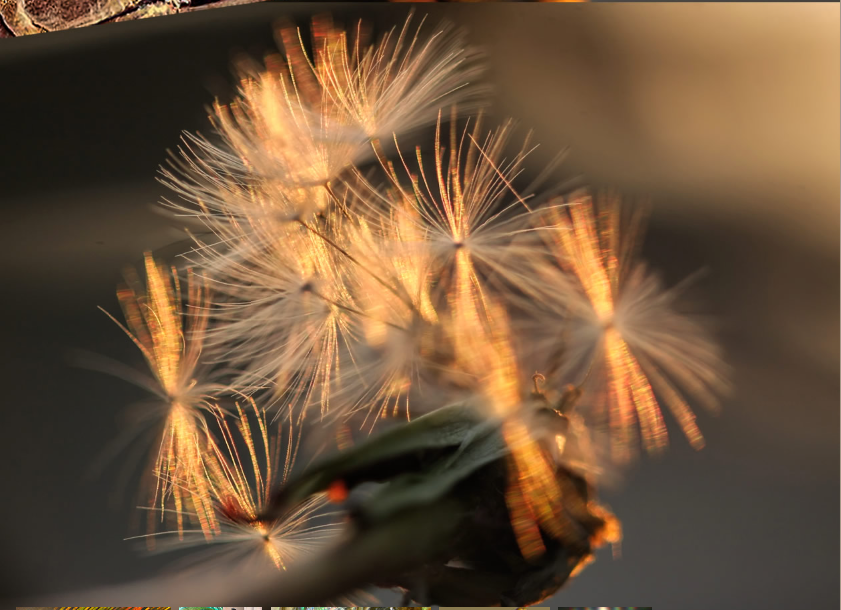Dandelion Diffraction - OPOD
Dandelion Diffraction: Unveiling the Multicolored Bands
When you gaze upon a dandelion's seed head, you may notice something mesmerizing - multicolored bands that resemble the ethereal beauty of out-of-focus spider silk. These captivating bands, which can also be observed on spider webs and even animal hair, are best seen when intentionally defocusing a camera. They are formed by the diffraction of sunlight, as quasi-regular structures interact with the incident light waves.
To understand the origins of these colorful bands, we must delve into the intricate anatomy of the dandelion seed head. Often regarded as a garden nuisance, the common dandelion surprisingly harbors a marvelous mechanism within its seed head or pappus. As the seed head matures, it transforms into the familiar puff-ball, where each hair serves as a vehicle for wind dispersal. The hairs themselves are constructed from numerous small hollow pipes, which provide both strength and lightweight structure to carry the dandelion's seeds.
Upon closer inspection, these individual hairs reveal semi-regularly spaced protuberances that play a crucial role in the formation of the color bands. These protuberances are believed to aid in the adhesion of the dandelion seeds upon landing or potentially serve other functions yet to be fully understood. However, one thing is certain - these protuberances possess the ability to diffract light and give rise to the stunning multicolored displays we observe.
To comprehend the phenomenon of dandelion diffraction, it is helpful to consider the concept of a regular diffraction grating. In a regular grating, equally spaced scratches, openings, or protuberances scatter incident light, resulting in an outgoing wave. As these waves overlap and interfere, some become in-phase, while others become out-of-phase. This interference pattern leads to specific directions where overlapping waves are in-phase, generating brightness for particular colors.
When it comes to dandelion diffraction, the protuberances on the seed hairs act as a type of irregular diffraction grating. The irregular spacing of these protuberances gives rise to unique diffraction patterns, causing the incident sunlight to disperse into its constituent colors. As a result, we witness the enchanting multicolored bands that grace dandelion seed heads, spider webs, and even animal hair.
The diffraction phenomenon exhibited by dandelions is not exclusive to these plants alone. Similar multicolored bands can be observed in various natural structures that possess quasi-regular diffraction gratings. Spider webs, for instance, often showcase vibrant colors due to the diffraction of light on the fine silk threads spun by spiders. Animal hair, particularly when viewed under specific lighting conditions, can also exhibit diffraction-induced coloration.
In the realm of atmospheric optics, dandelion diffraction serves as a captivating example of the interplay between light and natural structures. By unraveling the mechanisms behind these mesmerizing displays, scientists and enthusiasts alike gain a deeper appreciation for the wonders that exist within our everyday surroundings. Whether it be the delicate intricacies of a dandelion seed head or the gossamer threads of a spider's web, nature never ceases to amaze us with its breathtaking beauty and scientific marvels.
So, the next time you encounter a dandelion, take a moment to appreciate the hidden spectacle within its seed head. Marvel at the multicolored bands that dance before your eyes, and let the enchantment of dandelion diffraction remind you of the intricate wonders that await our discovery in the natural world.

Dandelion Diffraction
The seed head hairs of a dandelion gleam and display multicoloured bands like those of out-of-focus spider silk. Images by Daniela Rapava of KHaP M. Hella Observatory, Slovakia.
©Daniela Rapava, shown with permission

Multi-coloured bands are best seen when the camera is deliberately defocused. They are seen on spider webs and sometimes even animal hair. Quasi-regular structures of some kind must form them by diffracting the incident sunlight. The diffracting structures of the dandelion seed heads are likely to be protuberances on the individual seed hairs.
A regular diffraction grating. Each equally spaced scratch, opening or protuberance scatters light into an outgoing wave. The waves overlap and interfere. In-phase waves persist, out-of-phase waves destruct. Because the structure and therefore wave spacing is regular there are directions where the overlaps are in-phase and give brightness for a particular colour.
The common dandelion, thought of mostly as a garden nuisance, is the most marvellous device. Here are components of the seed head or pappus. They open into the familiar puff-ball. Each hair carries a seed to be borne by winds and breezes. The individual hairs are constructed from many small hollow pipes giving a strong but lightweight structure. The hairs have semi-regularly spaced protuberances that maybe help them stick where they land or perhaps have some other function. One thing they will do � they diffract light to form the colour bands.
Scanning electron microscope image by London Natural History Museum - science photo library.

Note: this article has been automatically converted from the old site and may not appear as intended. You can find the original article here.
Reference Atmospheric Optics
If you use any of the definitions, information, or data presented on Atmospheric Optics, please copy the link or reference below to properly credit us as the reference source. Thank you!
-
<a href="https://atoptics.co.uk/blog/dandelion-diffraction-opod/">Dandelion Diffraction - OPOD</a>
-
"Dandelion Diffraction - OPOD". Atmospheric Optics. Accessed on April 18, 2024. https://atoptics.co.uk/blog/dandelion-diffraction-opod/.
-
"Dandelion Diffraction - OPOD". Atmospheric Optics, https://atoptics.co.uk/blog/dandelion-diffraction-opod/. Accessed 18 April, 2024
-
Dandelion Diffraction - OPOD. Atmospheric Optics. Retrieved from https://atoptics.co.uk/blog/dandelion-diffraction-opod/.